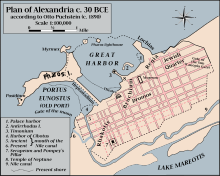Alexandria Port
| Port of Alexandria | |
|---|---|
 Click on the map for a fullscreen view | |
| Location | |
| Country | Egypt |
| Location | Alexandria |
| Coordinates | 31°12′16″N 29°52′48″E / 31.2045796°N 29.8800659°E |
| UN/LOCODE | EGALY[1] |
| Details | |
| Operated by | Alexandria Port Authority |
| Type of harbour | Coastal breakwater |
| Size of harbour | 16 square kilometres (6.2 sq mi) |
| Land area | 22.8 square kilometres (8.8 sq mi) |
| No. of berths | 67 |
| Statistics | |
| Annual cargo tonnage | 17,627,762 (2012) |
| Annual container volume | 1,442,712 (2012) |
| Website Official website | |
The Port of Alexandria is located on the
Alexandria is now considered the second most important city in Egypt and the Port of Alexandria is the main port in the country. It consists of two harbours (East and West) separated by a T-shaped peninsula. The East harbour is shallow and is not navigable by large vessels. The West harbour is used for commercial shipping. The harbour is formed by two converging breakwaters.
History
Ancient times
Alexandria Port is one of the oldest ports in the world. The earliest port facilities were built in 1900 BC in the then-village of

Over the centuries sand and silt deposits made the port unnavigable. It was cleared by forces under the command of Alexander the Great in 331 BC as part of the construction of Alexandria city to be the marine base for his fleet. Alexander's engineer Dinocrat linked the port of Alexandria and the island of Pharos with a bridge 1200 meters long and 200 meters wide, creating two harbour basins for commercial and military shipping. The northeast basin (Portus Magnus, currently the Eastern harbour) was designed for military vessels and the southwest basin (Portus Eunostus, currently the main port of Alexandria) was for commercial use. In the Ptolemy era a second bridge was built to Pharos, further dividing the eastern harbour into two separate inlets.
According to
Modern era

During
By the late 20th century sea trade through the Port of Alexandria was exceeding its capacity. A new port was built at
The
Egypt has a total of 15 commercial ports along the Mediterranean and Red Sea coasts. Alexandria Port, controlled by the Alexandria Port Authority, is the country's largest and it handles approximately 55% of Egypt's international trade.[6] Overall Alexandria's various harbours handle over three quarters of Egypt's foreign trade, with nearly 80% of the country's imports and exports passing through the city.[7]
Geography
The western port is divided into several zones:
- Used for general cargo handling.
- Deals with four types of activities: unified cargoes including a discharge.
- Used for handling general cargo and barge discharge.
- Used for handling containers, cement, coal, barge discharge, fertilizers, and general cargo.
- Used for handling: .
- (Oil Dock): Situated at the western boundaries of the port, is used for handling edible oil, oil products and for providing bunkers. It also includes berths used for handling livestock. The port does not include oil storage facilities, but oil berths are connected to a refinery through a 2 km long pipeline.
See also
References
- ^ "UNLOCODE (EG) - EGYPT". service.unece.org. Retrieved 28 April 2020.
- ISBN 9789774166143.
- ISBN 9780801885419.
- ISBN 9780806145280.
- ISBN 9781860645471.
- ISBN 9781907065408.
- ISBN 9781933766010.
External links
- The official site of the Alexandria Port Authority
- Map of Alexandria port, 1817. Eran Laor Cartographic Collection, The National Library of Israel.
